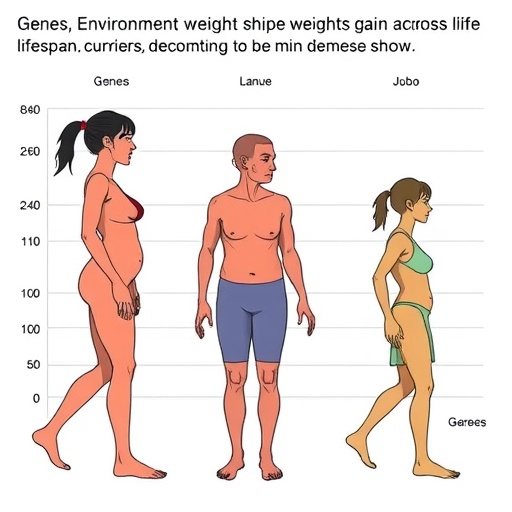In the ever-evolving landscape of autism spectrum disorder (ASD) research, the exploration of early diagnostic methods has become a focal point of scientific inquiry. Recent advancements have harnessed cutting-edge technologies, with eye-tracking emerging as a compelling approach. Researchers, led by da Silva, Martins, and Neto, have delineated the potential of eye-tracking technology in a groundbreaking study that seeks to determine if early diagnosis of ASD is feasible within nursery settings. Their large-scale real-life experiment provides fascinating insights into not only the capabilities of eye tracking but also the implications of these findings for the future of autism diagnosis.
Eye tracking, a technology traditionally utilized in psychology and neuroscience, allows for the precise measurement of eye movements, offering researchers valuable data regarding visual attention and cognitive processing. In the context of ASD, abnormalities in eye gaze and attention patterns may serve as critical markers for the disorder. This study posits that by observing the eye movement patterns of children in nursery environments, researchers might identify distinctive behaviors that could signal the early onset of ASD, potentially well before conventional assessments take place.
The researchers assembled an extensive dataset by implementing eye-tracking technology across a significant population of children in nursery settings. The study’s design focused on creating a comprehensive analysis of how children with and without ASD differ in their visual engagement with their surroundings. By analyzing the collected data, the researchers aimed to ascertain whether specific eye movement behaviors could reliably indicate the risk of developing ASD. What transpired from this extensive data collection was a gradual unfolding of patterns that suggest unique visual processing characteristics among those on the autism spectrum.
Significantly, the study’s findings suggest that children diagnosed with ASD display markedly divergent eye-tracking patterns in comparison to their neurotypical peers. For instance, children with ASD were shown to have reduced fixations on social stimuli, such as faces, and exhibited less engagement with dynamic objects in their environment. This critical data opens the floodgates to the potential for eye-tracking technology to act as a non-invasive, objective tool for early screening applications in early childhood education settings. As early intervention is paramount in improving developmental outcomes for children with ASD, these findings are poised to influence both clinical practices and educational policies surrounding autism diagnostics.
Moreover, the potential for eye tracking as a standard screening practice is underscored by its accessibility. Unlike other intensive diagnostic methods that may require expertise and resources often limited to specialized clinics, eye tracking could be effectively integrated into the nursery routine. This approach has far-reaching implications, especially in areas where access to comprehensive autism evaluations is limited. As such, the research encourages a paradigm shift towards proactive screening practices, aiming to catch signs of autism as early as possible.
The implications of the study extend beyond just the individual child; they also encompass a broader understanding of how society approaches autism diagnosis. As awareness of autism grows, so too does the pressing need for innovative screening methods that can operate within real-world contexts. By fostering an environment where early signs of ASD can be detected and addressed, we can create a more inclusive society that prioritizes the developmental and educational needs of children on the spectrum.
The study also highlights the necessity for collaborations across disciplines—bringing together educators, psychologists, and technologists—to further explore how eye-tracking technology can be effectively used in educational settings. By fostering an interdisciplinary approach, the researchers hope to not only solidify the conclusions drawn from their data but to elevate the conversation surrounding autism diagnostics to new heights. Such collaborations can pave the way for creating tailored interventions that address the unique needs of children with ASD.
In the aftermath of this research, questions arise about how to implement these findings into everyday practices. Educators and caregivers must be equipped with the knowledge to recognize the significance of eye-tracking data. Professional development opportunities could be cultivated to ensure that those working closely with young children understand how to utilize this technology effectively. As a community, building competency in interpreting eye-tracking results could greatly enhance the efficacy of early screening processes and ultimately improve outcomes for children with ASD.
Furthermore, the researchers advocate for continued investment in technology-driven solutions to augment traditional diagnostic practices. As new innovations emerge, it will be crucial to incorporate them into existing frameworks to identify and support children at risk of developing ASD. This includes not only the development of new tools but also ensuring that any proposed solutions are scalable and sustainable within diverse educational systems. The vision is to foster environments where every child receives the attention they require, irrespective of their background or access to resources.
While this study provides a promising avenue toward improving early detection of ASD, it is vital for the scientific community to proceed with caution. Future research is necessary to validate the findings across varying populations and settings to ensure broad applicability. This includes examining how cultural differences may influence eye-tracking behaviors, as well as considering how other variables—such as language acquisition and social context—might interact with the indicators of ASD.
The implications of adopting eye-tracking technology within nursery settings have the potential to transform early interventions. By identifying at-risk children as young as possible, clinicians can tailor support and services that directly address each child’s unique developmental trajectory, facilitating a more personalized approach to autism care. The hope is that such interventions will lead to significantly improved outcomes for children on the spectrum, enabling them to thrive in both academic and social environments.
Transitioning thoughts from this research into actionable strategies requires a collective effort among stakeholders, including policymakers, educational institutions, and families. Raising awareness about the potential benefits of early diagnosis through eye-tracking should encourage engagement from all fronts. The objective is to create a united front advocating for the implementation of innovative screening practices that emphasize the importance of early intervention in promoting lifelong success for individuals with ASD.
In conclusion, the pioneering study led by da Silva, Martins, and Neto marks a significant step forward in the realm of autism research. By leveraging advanced eye-tracking technology, they have opened a conversation not only about the feasibility of early diagnosis in nursery settings but also about broader implications for society as a whole. With careful consideration and a commitment to interdisciplinary collaboration, there lies a profound opportunity to reshape how we understand and support children on the autism spectrum, ultimately leading to richer, more fulfilling lives for them.
Subject of Research: Early diagnosis of autism spectrum disorder (ASD) through eye tracking in nursery settings.
Article Title: Correction: Eye Tracking Screening for ASD in Nursery: Is Early Diagnosis Possible? A Large-scale Real-life Experiment.
Article References: da Silva, V.H., Martins, Y.R., Neto, P.A.S.O. et al. Correction: Eye Tracking Screening for ASD in Nursery: Is Early Diagnosis Possible? A Large-scale Real-life Experiment. J Autism Dev Disord (2025). https://doi.org/10.1007/s10803-025-07138-7
Image Credits: AI Generated
DOI:
Keywords: Eye Tracking, Autism Spectrum Disorder, Early Diagnosis, Nursery Settings, Visual Processing.
Tags: advancements in ASD diagnostic methodscognitive processing in autism researchearly diagnosis of autism spectrum disordereye movement patterns and ASDeye tracking technology in autism diagnosisgroundbreaking research in eye trackingidentifying early signs of autismimplications of eye tracking for autismlarge-scale study on ASDnursery settings for ASD assessmentresearchers in autism spectrum disordervisual attention patterns in children




